
Maurice Dufrêne (1876-1955)

Maurice Dufrêne (1925)
Decorative artist Maurice Dufrêne was born in Paris in 1876. He showed interest in the decorative arts as a boy, using wood, cardboard and fabric he got from his father's wholesale commodities business. Despite this beginning, Dufrêne chose to become a painter, studying at the École nationale supérieure des arts décoratifs. He eventually abandoned the study of painting and turned to the commercial world, making items and displays more in line with his original interest.
In 1899, Dufrêne was hired as director and manager at La Maison Moderne, a shop which was founded by Julius Meier-Graefe in 1895 to showcase Art Nouveau pieces. Graefe was particularly interested in create pieces for the home. The shop functioned as a co-op of artists working together to create designs for limited mass production. To promote his own work, Dufrêne began displaying his designs in 1902 at the French salons (exhibitions of work by living artists). In 1903, he exhibited at the Salon d'Automne and the Salons of Société Nationale des Beaux-Arts. Exhibitions and salons provided decorative artists the opportunity to showcase their work and garner design commissions, an important part of a designers income during the first thirty years of the twentieth century.
Following the 1900 Exposition Universelle in Paris, the Société des Artistes Décorateurs formed as an informal collective of artists to promote French designs. "It was aimed to satisfy the demand of the prosperous urban elite for high-quality French craftsmanship and cabinetmaking. The society's salons were the first official means of encouraging new standards for design and production in France." ("Société des artistes décorateurs", Wikipedia, gathered 4-15-25) Dufrêne was one of six founding members of the group and began exhibiting at their first Salon in 1904. He continued to exhibit for the following 30 years at the salon.
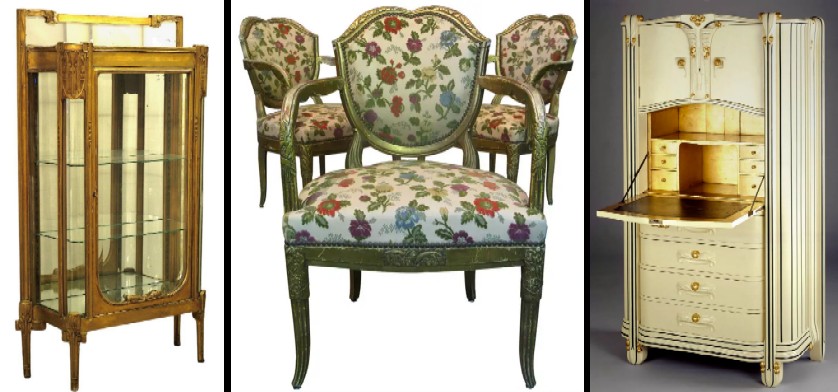 Dufrêne Transitional Designs, From left - Vitrine/Cabinet, Handcarved Giltwood, c. 1912, 1st Dibs; Dufrene, Floral Motif Arm Chairs, Wood and Fabric, 1910s, 1st Dibs; Secretary, Painted Wood, Gold Leaf and Leather, c. 1912, Montreal Museum of Fine Arts
Dufrêne Transitional Designs, From left - Vitrine/Cabinet, Handcarved Giltwood, c. 1912, 1st Dibs; Dufrene, Floral Motif Arm Chairs, Wood and Fabric, 1910s, 1st Dibs; Secretary, Painted Wood, Gold Leaf and Leather, c. 1912, Montreal Museum of Fine Arts
La Maison Moderne went bankrupt in 1903. No longer holding his managing position
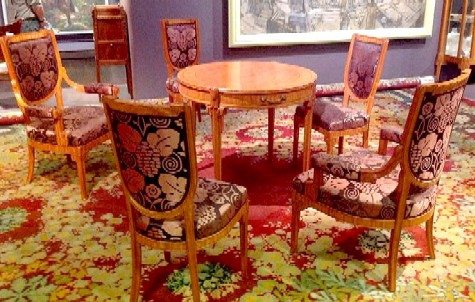
Table and Chairs by Maurice Dufrêne with Gobelin carpet by Paul Follot,
Salon des Artistes Decorateur (1912) Wikimedia
Dufrene embarked on a liberal practice, designing interiors for private and institutional clients, drawing models of all kinds of utilitarian or decorative objects mass-produced by industry; Gradually freeing himself from the artifices of the "Art Nouveau" style in the early 1910s, he participated in his own way in the experiments of the renovators (André Groult, André Maré, Louis Sué, Émile Jacques Ruhlmann) in search of a new style that would only become clear after the war. His reputation as a versatile professional was established all the more easily because he never missed an opportunity to make his achievements known through the new Decorative Art Salons... By the end of the first decade of the century, he was considered a brilliant and competent young decorator who could be entrusted with large-scale projects. (Alaine-Rene Hardy and Gaelle Millet, Jacques Adnet, 2009, p. 17)
After 1910, his work had a neoclassical form which was gradually transformed into Art Deco style. "While he didn’t shy from metal, ceramic, glass, or fabric, Dufrêne executed most of his designs without excessive frills or ornament—often simply, in lush woods like mahogany. A deep respect for craftsmanship is his work’s fundamental characteristic, and his furniture is as functional as it is elegant." ("Maurice Dufrêne", Maison Gerard website, gathered 4-16-25)
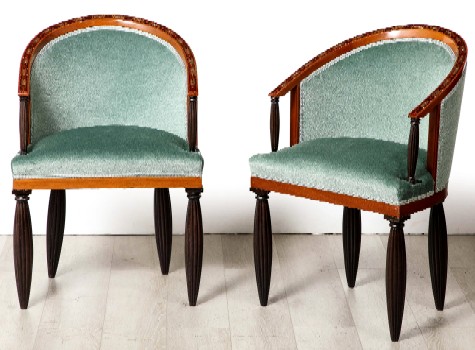
Maurice Dufrêne Barrel Back Chairs, Rosewood Legs, Reupholstered, c. 1921,
Guy Regal NYC
From 1912 to 1923, Dufrêne taught decorative composition at the École Boulle in Paris, a college of fine and applied arts. Here he would have met many up-and-coming designers which would prove useful when he began looking for talent at Galeries Lafayette. He also taught at the École des Arts Appliqués, a post-graduate school for the decorative arts. His experience working with young artists combined with his twin experiences designing s well as managing designers combined with his desire to transition from Art Nouveau to a new style made him a respected figure in the Art Deco era.
Likely because of his standing the department store Galeries Lafayette opened their La Matrise applied arts workshops soon after the war in 1922. They chose Dufrêne to be their artistic director, wanting the workshop to produce products in the 'modern style' with an eye on the need for post-war reconstruction. The goal of this and other, similar deparment store workshops was "to produce 'works' (furniture, fabric, carpets, wallpaper, pottery etc.) accessible to budgets both large and small." ("The Tale of Galeries Lafayette…", Haussmann Galeries website, gathered 4-15-25) Just as he had expressed a desire to produce limited mass-produced products while managing La Maison Moderne, Dufrêne again turned his attention in this direction at Galeries Lafayette. In this new role he was able "to reconnect with his original ambition: to offer quality, aesthetically pleasing, mass-produced furniture for the benefit of as many people as possible. The objects and furniture pieces he developed there incorporated a variety of materials, typical of the era: wood, of course, as well as glass and fabric, but also silver and ceramic. A major challenge both in terms of production and marketing." ("Maurice Dufrène", du Grande Arte website, gathered 4-15-25)
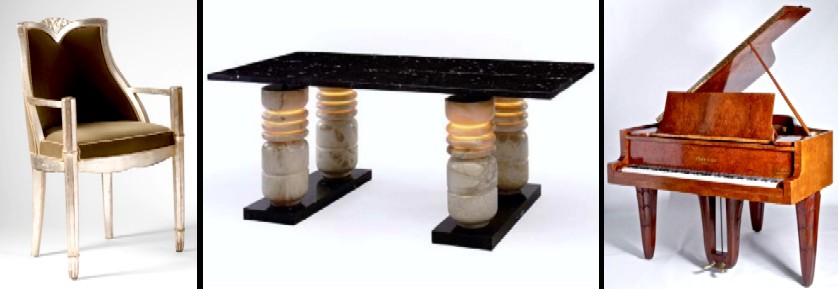 Dufrêne Furniture for Galeries Lafayette, From left - Arm Chair, Silvered Wood and Upholstery, c. 1925, Maison Gerard; Table, Illuminated Marble and Alabaster, 1939, Invaluable; Piano, Amboyna Wood, Instrument by Gaveau, Signed, From the 1925 Paris Exposition, 1925, Incollect
Dufrêne Furniture for Galeries Lafayette, From left - Arm Chair, Silvered Wood and Upholstery, c. 1925, Maison Gerard; Table, Illuminated Marble and Alabaster, 1939, Invaluable; Piano, Amboyna Wood, Instrument by Gaveau, Signed, From the 1925 Paris Exposition, 1925, Incollect
As head of Galeries Lafayette, Dufrêne was heavily involved in the creation of their pavilion for the 1925 Exposition Internationale des Arts Décoratifs et Industriels Modernes. Literature apparently reproduced from the event on the World Fairs website explains:

La Matrise pavilion, 1925 Exposition Internationale des Arts
Décoratifs et Industriels Modernes, Riba Pix
The Pavilion of the "Maîtrise" is the result of a competition established between all French architects, whose jury, presided over by Mr. Paul Léon, director of the Beaux-Arts, had awarded the first prize to the project of three young artists: Messrs Tribout, Hiriard and Beau. It is their work that has been fully realised.
As for the interior, which is entirely the work of our "Maîtrise" workshop, Maurice Dufrène and his collaborators, it appears with its seven rooms as one of the most characteristic ensembles of current French taste. We wanted, and our collaborators helped us wonderfully, to continue the great and healthy tradition, to create furniture, carpets, fabrics, etc., adapted to our present life, to carry out a decoration in conformity with our manners, our tastes, our customs, to constitute, in a word, the environment where moves, with its feelings, its new uses, the modern Man, eager to live in the peace and the joy of a personal home. ("La Maîtrise - Grands Magasins des Galeries Lafayette - Expo Paris 1925", World Fairs website, gathered 4-16-25)
Looking back at the design presented by Dufrêne and Galeries Lafayette, Professor Arthur Chandler says,
The most daring of the four stores, however, was the Galleries Lafayette (Hiriart, Tribout, and Beau, architects). The Art Deco facade and interior were faced in a richly textured marble. A bold, flaring sunburst design greeted visitors as they passed into the interior. Inside, the theme of the major exhibit was "la vie en rose": a display of the boudoir of the tasteful and wealthy woman of fashion in the 1920s who knew how to coordinate the angular lines of Art Deco with a sense of stylish grace. The furnishings were in rose hues, offset with silver and black marble. In every respect, the furnishings reflected the ideas of Maurice Dufrene, director of the Lafayette studios". (Chandler, "The Art Deco Exposition" Arthur Chandler website, gathered 4-15-25)
In addition to the Maîtrise pavilion, Dufrêne designed some of the exposition’s luxury boutiques, a music salon, and the dining room for the French Embassy pavilion created by the members of the Société des Artistes Décorateurs. (See the image below.)
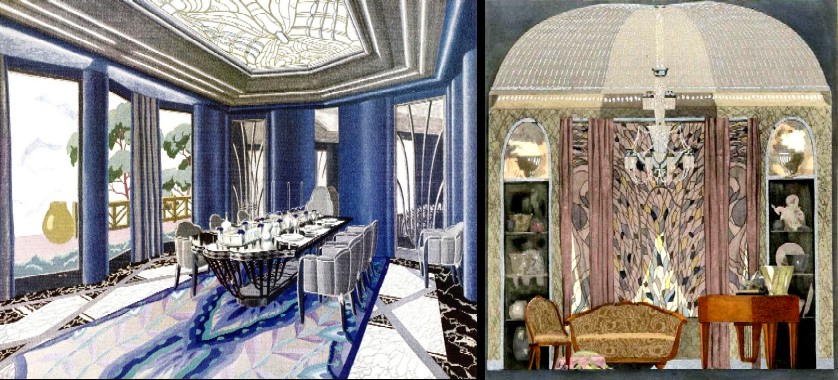 Dufrêne Rooms at the 1925 Exposition Internationale des Arts Décoratifs et Industriels Modernes, From left - Dining Room, Maurice Dufrene, From Interieurs en Couleurs, Plate 28, 1926; Small Sitting Room, From Une ambassade française, by Société des Artistes Décorateurs, Plate 10, 1925
Dufrêne Rooms at the 1925 Exposition Internationale des Arts Décoratifs et Industriels Modernes, From left - Dining Room, Maurice Dufrene, From Interieurs en Couleurs, Plate 28, 1926; Small Sitting Room, From Une ambassade française, by Société des Artistes Décorateurs, Plate 10, 1925(Note that the second room contains the piano seen in the previous furniture image.)
Dufrène's Art Deco style combined austere structure with some neoclassical decoration. "Dufrêne's furniture reveals and appreciation for craft and workshop production, and from the second decade of the twentieth century he embraced a rational, self-contained approach to design... simple harmony between structure and decoration." (David Raizman, History of Modern Design: Graphics and Products Since the Industrial Revolution, 2003 p. 145) "He produced designs for Christofle, a large firm that manufactured high-quality Art Deco metalwork in the 1920s and
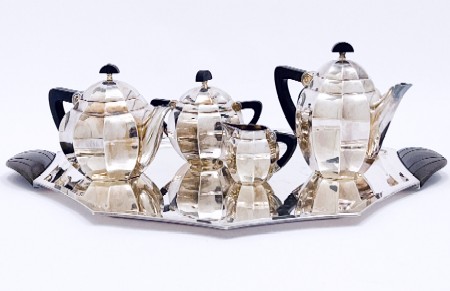
Coffee Service for Orfèvrerie Gallia-Christofle, Silver-Plate, 1920s,
Capsule Auctions
1930s. [See the image at left.] The 1930s were no less frenetic. The earlier predilection for wood gave way gradually to metal and glass. At sixty years of age, Dufréne could still adapt, as he had shown during the demise of Art Nouveau a quarter of a century earlier." ("Maurice Dufrêne: Influence on 20th-century French Decorative Arts", Encyclopedia.design website, gathered 4-15-24)
"Over the years, Maurice Dufrène's entrepreneurial spirit and curiosity led him to become a true jack-of-all-trades: cabinetmaker, interior designer, set designer... This ability to adapt to any type of project, from buildings to furniture and interior design, allowed him to diversify his projects and gain ever-increasing popularity. He was thus entrusted with prestigious assignments." (du Grande Arte website)
Dufrêne remained head of Galeries Lafayette until his retirement in 1952. He also produced some tableware for the French silver company Christofle in the 1920s and 30s. Some of his commissions included rooms for the Palais de l'Elysee as well as embassies designed on behalf of Le Mobilier National. Dufrène was appointed to be a member of the Professional Organizing Committee for the Graphic and Plastic Arts during the Second World War for the Vichy regime which worked with the Nazis. "This part of his life tainted Maurice Dufrène's original vocation: to democratize the Decorative Arts, at a time when artisans chose to work almost exclusively for a very wealthy clientele." (du Grande Arte website)
Sources Not Mentioned Above:
"La Maison Moderne", The British Museum website, gathered 4-15-25
"Maurice Dufrêne", Maison Gerard website, gathered 4-15-24
"Maurice Dufrene low center table", Incollect website, gathered 5-15-25
"Maurice Dufrène", Artnet website, gathered 4-15-25
"Exposition Universelle (1900)", Wikipedia, gathered 4-15-25
Original Facebook Group Posting
 Dufrene Furniture Designs, From left - Club Chair, Mahogany and Fabric, Galeries Lafayette, c. 1925, Billings Auction; Oval Dining Room Table, Mahogany and Burr Sandalwood, La Matrise, c. 1923, Invaluable; Lady's Desk and Chair, Amboyna, Ebonized Wood and Gilt-Bronze, Leather Uphostelry, 1932, Sotheby's
Dufrene Furniture Designs, From left - Club Chair, Mahogany and Fabric, Galeries Lafayette, c. 1925, Billings Auction; Oval Dining Room Table, Mahogany and Burr Sandalwood, La Matrise, c. 1923, Invaluable; Lady's Desk and Chair, Amboyna, Ebonized Wood and Gilt-Bronze, Leather Uphostelry, 1932, Sotheby's